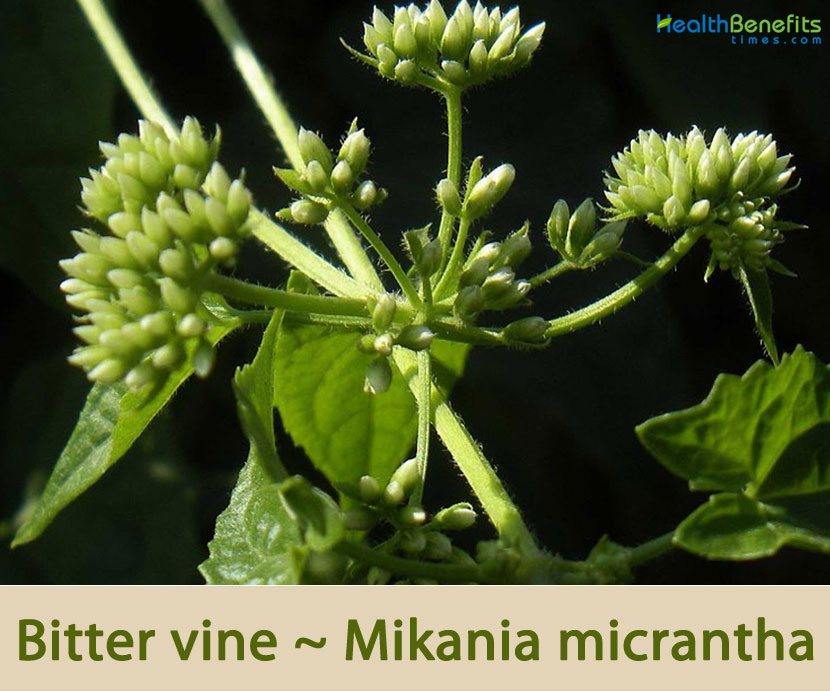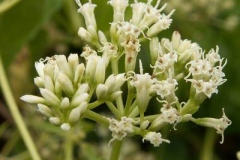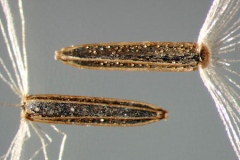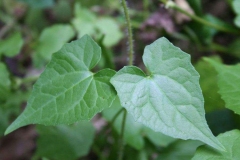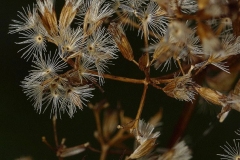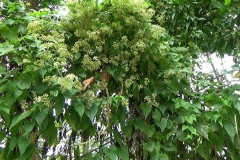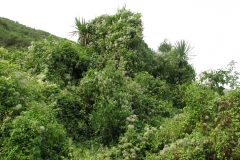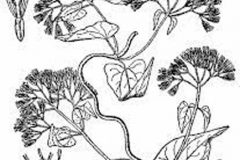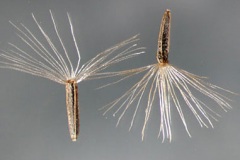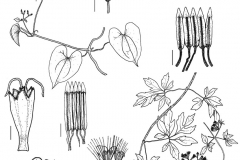Some of the popular common names of the plant include American rope, bitter vine, bittervine, Chinese creeper, climbing hemp vine, climbing hempvine, climbing hempweed, mikania, mikania vine, mile a minute, mile a minute weed, mile-a-minute and mile-a-minute weed. The plant is harvested from the wild for local use as a medicine. It is also cultivated as an ornamental and ground cover plant, though because of its ability to spread as a weed these uses should be discouraged outside of the plant’s native range.
Bitter Vine Facts
| Bitter vine Quick Facts | |
|---|---|
| Name: | Bitter vine |
| Scientific Name: | Mikania micrantha |
| Origin | Mexico, Central America, the Caribbean and tropical South America |
| Colors | Black or blackish-brown |
| Shapes | Achene, linear-oblong, 1.5 to 2 mm long, black, five-angled, glabrous |
| Health benefits | Upset stomach, itching itchy, lame, wound infections, rheumatism, menstrual pain, bloating, diarrhea, influenza, diabetes and bone pain, malaria. |
| Name | Bitter vine |
|---|---|
| Scientific Name | Mikania micrantha |
| Native | Mexico, Central America (i.e. Belize, Costa Rica, El Salvador, Guatemala, Nicaragua and Panama), the Caribbean (i.e. Cuba, Dominica, Grenada, Guadeloupe, Martinique and St. Lucia) and tropical South America (i.e. French Guiana, Guyana, Surinam, Venezuela, Brazil, Bolivia, Colombia, Ecuador, Peru and Argentina). It also naturalized in tropical Asia (e.g. India, Nepal, Bangladesh, Sri Lanka, China, Indonesia, Malaysia, Brunei, the Philippines, Singapore, Thailand and Papua New Guinea), the Mascarenes (e.g. Mauritius), Melanesia, Polynesia and Hawaii |
| Common Names | American rope, bitter vine, bittervine, Chinese creeper, climbing hemp vine, climbing hempvine, climbing hempweed, mikania, mikania vine, mile a minute, mile a minute weed, mile-a-minute, mile-a-minute weed |
| Name in Other Languages | American Samoa: Fue saina Assamese: Japani-lota (জাপানী লতা) Chinese: Wei gan ju (薇甘菊), Xiǎohuā màn zé lán (小花蔓澤蘭) Cook Islands: Po kutekute English: American rope, Chinese creeper, bittervine, climbing hempweed, mikania vine, mile-a-minute weed, Mile-a-minute Fijian: Ovaova, usuvanua, wa bosucu, wa butako, wa mbosuthu, wa mbosuvu, wa mbutako, wa ndamele French: Liane américaine, liane serpent Germany: Sommer-Efeu Haitian: Bwa zamann Hindi: Japani habi Indonesia: Sembang rambat, brojo lego, blukar, hila hitu lama Japanese: Tsuruhiyodori (ツルヒヨドリ) Kwara‘ae: Kwalo kalialo, kwalo kauburu Malay: Selaput tunggul Malayalam: Dhr̥tarāṣṭrappacca (ധൃതരാഷ്ട്രപ്പച്ച) Malaysia: Cheroma, ulam tikas, akar lupang, selaput tunggul Manipuri: Uri hingchabi (ꯎꯔꯤ ꯍꯤꯡꯆꯥꯕꯤ) Maori (Cook Islands): Pō kutekute Micronesia, Federated states of: Selmwadang, selmwadang Mizo: Japanhlo Nepali: Lahare Banamaaraa (लहरे बनमारा) Niuean: Fou laina, fue saina Palauan: Teb el yas Peru: Camotille Philippines: Bikas, detidid, uoko Pohnpeian: Selmwadang Portuguese: Guaco, carobinha, guaco-verdadeiro Saint Lucia: Kacho Samoan: Fue saina Solomon Islands: Kwalo kalialo, kwalo kauburu Spanish: Camotille, guaco, wappe, cepucillo, bejuco de finca, tumba finca Thai: Khikaiyan (ขี้ไก่ย่าน) Sudanese: Areuy |
| Plant Growth Habit | Vigorous, fast-growing, much-branched, perennial, scrambling, twining, slender-stemmed vine |
| Growing Climates | Disturbed forest, stream banks, roadsides, pastures, plantations and cultivated crops, swampy woods, bushes of moist places, forest borders, in clearings, thickets, second-growth forest, along fence-lines, wastelands, wet places, railway tracks and barren lands |
| Soil | Grows best where fertility, organic matter, and soil and air humidities are all high |
| Plant Size | Up to 6 meters (20 ft.) or more long |
| Stem | Small rod, cylindrical or hexagonal, full, often very branched and intertwined, yellowish to brown. Young stems bear a pubescence sparse, then become glabrous with age. |
| Leaf | Leaves are oppositely arranged about 4-13 cm long and 2-9 cm wide and either heart-shaped (i.e. cordate) or somewhat triangular in shape with a long pointed tip (i.e. acuminate apex) |
| Flowering season | August to February |
| Flower | Numerous fluffy flower-heads (i.e. capitula) are borne in branched clusters originating in the forks of the leaves or forming at the tips of the branches (i.e. in axillary or terminal corymbs). These flower-heads (i.e. capitula) are small (3-6 mm long) and white or greenish-white in color. They do not have any obvious petals (i.e. they have no ray florets) and consist of four tiny flowers |
| Fruit Shape & Size | Achene, somewhat flattened, linear-oblong, 1.5 to 2 mm long, black, five-angled, glabrous, 4-ribbed with short, white hairs along the ribs, with a tuft of white pappus at the summit, glandular, 1.2-1.8 mm long, dark grey to black |
| Fruit Color | Black or blackish-brown |
| Propagation | By seeds, and vegetatively by rooting at nodes |
| Plant Parts Used | Leaves, stem |
| Season | October and April |
| Culinary Uses |
|
| Precautions |
|
Plant Description
Bitter vine is a vigorous, fast-growing, much-branched, perennial, scrambling, twining, slender-stemmed vine that normally grows up to 6 meters (20 ft.) or more long. It grows very quickly (as fast as 80 to 90 millimetres (3.1 to 3.5 in) in 24 hours for a young plant) and covers other plants, shrubs and even trees. Mikania is a problem in Nepal, covering more than 20% of the Chitwan National Park. Mikania micrantha is a widespread weed in the tropics. The plant is found growing in disturbed forest, stream banks, roadsides, pastures, plantations and cultivated crops, swampy woods, bushes of moist places, forest borders, in clearings, thickets, and second-growth forest, along fence-lines, wastelands, wet places, railway tracks and barren lands. The plant grows best where fertility, organic matter, and soil and air humidities are all high. It is an aggressive weed which has now dominated many states of NE India, and has also naturalized in the Himalayas.
Stems
The slender stems are ribbed lengthwise (i.e. longitudinally) and are either hairless (i.e. glabrous) or slightly hairy (i.e. puberulent). These stems sometimes produce roots (i.e. adventitious roots) at their joints (i.e. nodes).
Leaves
Leaves are oppositely arranged about 4-13 cm long and 2-9 cm wide and either heart-shaped (i.e. cordate) or somewhat triangular in shape with a long pointed tip (i.e. acuminate apex). These leaves are borne on stalks (i.e. petioles) 2-8 cm long, are hairless (i.e. glabrous), and have coarsely toothed (i.e. dentate or crenate) margins.
Flowers
Numerous fluffy flower-heads (i.e. capitula) are borne in branched clusters originating in the forks of the leaves or forming at the tips of the branches (i.e. in axillary or terminal corymbs). These flower-heads (i.e. capitula) are small (3-6 mm long) and white or greenish-white in color. They do not have any obvious petals (i.e. they have no ray florets) and consist of four tiny flowers (i.e. tubular florets), each 3-4 mm long, surrounded by a row of four small green bracts (i.e. involucre). These bracts (2-4 mm long) are oblong to egg-shaped in outline (i.e. obovate) with pointed tips (i.e. acute apices). Flowering occurs mostly from late autumn through to early spring.
Fruit
The tiny black or blackish-brown ‘seeds’ (i.e. achenes) are elongated (i.e. linear-oblong) in shape and five-angled in cross-section and truncated at the top. These seeds are 1.2-2 mm long and 0.2-0.6 mm wide and are topped with a ring (i.e. pappus) of numerous (30-38) whitish coloured hairs or bristles that are 2-4 mm long, which can carry the seed large distances on air currents and attach itself to the hair of animals. A single stalk can produce between 20 and 40 thousand seeds a season.
Traditional uses and benefits of Bitter vine
- It has also been used as a medicinal herb in various countries as the plant is known to have antibacterial and antimicrobial properties.
- The gum of the leaves is used by some tribal people for treating snake, insect and scorpion bites in India.
- In Fiji, Samoa and, to a lesser extent, Papua New Guinea, it is used as a medicinal plant to treat cuts and nausea but its medicinal properties are still yet to be fully discovered.
- The leaves can be used as a topical ointment for eliminating discomfort of hornet, bee and ant stings.
- In Ecuador, it is reportedly used as a rat poison.
- The leaves are also used for treating stomachache.
- Juice of Mikania is used as a curative agent for itches in Malaysia.
- In Bangladesh used to treat gastric ulcer and as a local antiseptic.
- They are also used as a poultice for swellings, itches and wounds.
- Tea made from the whole plant is used as a treatment for stomach aches and to clean out the uterus (dilation and curettage).
- It is boiled with other plants to produce a tonic that can reduce malarial fever.
- Decoction of the stem and leaves is used as a remedy for a children’s clyster and to treat malaria and eczema.
- Stems are squeezed, mixed with ginger rhizomes and eaten with green vegetables as a remedy for colds, headaches and stomach aches.
- Leaves are antidote, cholagogue, diuretic and febrifuge.
- They are boiled, and the water drunk as an anti-menorrhagia.
- An infusion is used as a remedy for snakebite and syphilis.
- Juice of the leaves is applied topically in order to treat external ulcers and itch.
- Leaf in liquid mixture is used to treat children’s anal thrush, and it is placed in hot water bath for women after confinement for pregnancy.
- Decoction is used for a febrifuge bath.
- An infusion is used for washing the skin as a treatment for rashes, skin eruptions, smallpox, chicken pox and measles.
- Juice from the macerated leaves is applied to persistent sores and bush-yaws.
- Macerated leaves are vigorously rubbed on skin as a treatment for rashes.
- In Jamaica, its most popular uses are for wound dressings and promote the healing of sores as folk medicine.
- In Malaysia, the juice of the leaves is used to cure itchy on the skin.
- In Indonesia it is used for the treatment of upset stomach, itching itchy, lame, and wound infections, rheumatism, menstrual pain, bloating, diarrhea, influenza, diabetes and bone pain, malaria.
- In Malaysia, it is consumed as a juice (prepared by decoction method) to treat diabetes, stroke, hypertension and hypercholesterolemia.
- Leaves are used for treating stomach ache, jaundice, and placed in lukewarm water bath for women after confinement.
- It has also been reported that it is used to treat fever, rheumatism, cold and respiratory diseases.
Other Facts
- It has been used as a cover crop, for soil improvement or to prevent soil erosion.
- It has also been used as fodder for sheep and cattle in India, Malaysia and Fiji.
- It has been reported to increase the growth and yield of rice in India when used as green manure.
- It has also been used as a medicinal herb in various countries as the plant is known to have antibacterial and antimicrobial properties.
- One plant can cover more than 25 square meters in a few months using vegetative and generative production of 20,000-40,000 seeds per year to germinate optimally at a temperature of 24-32C.
Control
Mechanical
Sickle weeding, uprooting and digging are the main mechanical control methods in practice. Sickle weeding before flowering and seed setting gives temporary control. But quick re-growth from cut stumps frustrates this method. Uprooting during the initial stages of growth (before flowering and fruiting) is the most effective mechanical control method. The slash and burn technique is also practiced widely. However, the weed stock may survive burning and produce young shoots in a couple of months. Mechanical control method is very labor intensive and uneconomical. One advantage of this method is that it reduces the vegetative propagation of Mikania. In Indonesia, the cost of mechanical control of Mikania is estimated to be 125-175% higher than that of herbicidal control.
Chemical
Both pre-emergent and post-emergent herbicides are generally used for -1 Mikania control. Pre-emergence application of Oxyflourfen (0.06 kg ha) + Paraquat 1 (0.24 kg ha) is reported to be effective if applied before flowering or seed setting. Glyphosate is widely used in many countries against mikania, especially in forest 1 -1 plantation. Dosage used varies widely (0.5 to 4.5 kg ha or 0.75 to 8 l ha) depending on the intensity of infestation and number of applications required for effective control. -1 In general, the application of Glyphosate @ 2.5 – 5 l ha may take care of even heavy infestations. This herbicide can also inhibit germination of seeds of the weed. 1 Application of Diuron at the rate of 1-2 kg ha is also reported to be equally effective as -1 Glyphosate. Herbicides Triclopyr +Picloram (commercial name Grazon DS) @ 1.75 l ha -1 and Triclopyr (commercial name Garlon 600) @ 500 ml ha also gives excellent control of Mikania. All herbicidal applications should preferably be carried out before flowering and seed setting. It should also be borne in mind that though a single and thorough application of any one of these herbicides may control the weed for about a year, re-growth will occur in most areas through wind-borne seeds, especially after the onset of the monsoon. It may thus be necessary to repeat annual applications for the next few years, depending on the severity of re-infestation.
Biological
Biological control using a natural insect enemy, viz., Liothrips mikaniae from Trinidad, was attempted in the Solomon Islands and Malaysia but successful establishment was not achieved. Recent studies carried out by CABI Bioscience (UK) in collaboration with Kerala Forest Research Institute (India) and institutions under the Indian Council of Agricultural Research have shown that highly damaging microcyclic rust, viz., Puccinia spegazzinii, which naturally occurs and causes damage to Mikania in the neotropics, has great potential as a bio control agent against the weed. The fungus was tested for host specificity against closely related members of Asteraceae and a number of economically important plants and proved highly specific to Mikania. It was released recently in tea plantations in northeast India and agricultural systems in southwest India and preliminary results on spread of the pathogen in the field have been encouraging.
References:
https://www.itis.gov/servlet/SingleRpt/SingleRpt?search_topic=TSN&search_value=36046#null
http://www.hear.org/pier/species/mikania_micrantha.htm
https://www.cabi.org/isc/datasheet/34095#toPictures
https://en.wikipedia.org/wiki/Mikania_micrantha
https://apg.pir.sa.gov.au/gringlobal/taxonomydetail.aspx?id=316383
https://portal.wiktrop.org/species/show/210
http://www.flowersofindia.net/catalog/slides/Climbing%20Hempweed.html
https://uses.plantnet-project.org/en/Mikania_(PROSEA)
http://issg.org/database/species/ecology.asp?si=42&fr=1&sts=&lang=EN
https://keyserver.lucidcentral.org/weeds/data/media/Html/mikania_micrantha.htm
http://www.theplantlist.org/tpl1.1/record/gcc-1953
https://indiabiodiversity.org/species/show/230405
https://gd.eppo.int/taxon/MIKMI
http://tropical.theferns.info/viewtropical.php?id=Mikania+micrantha


